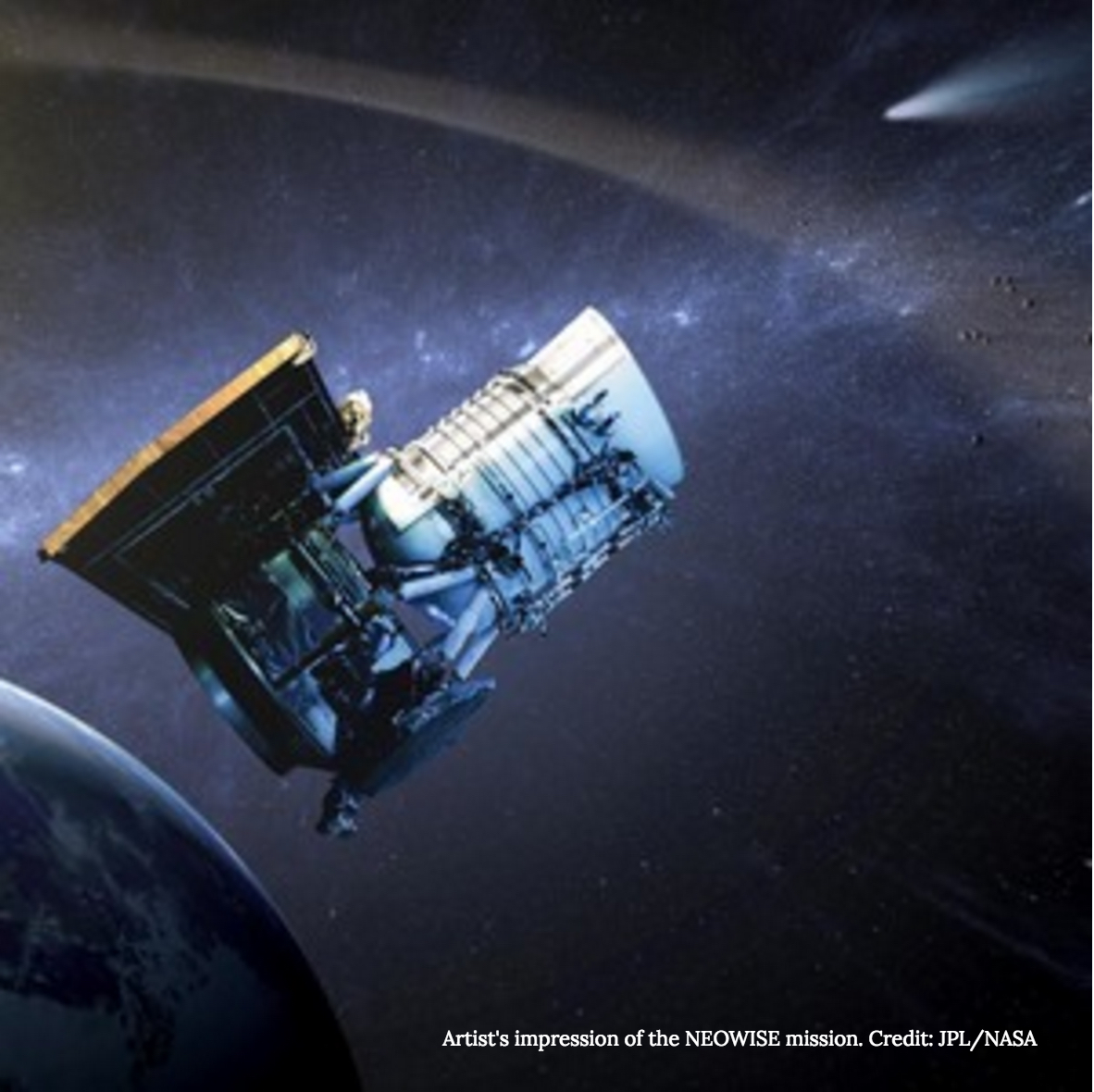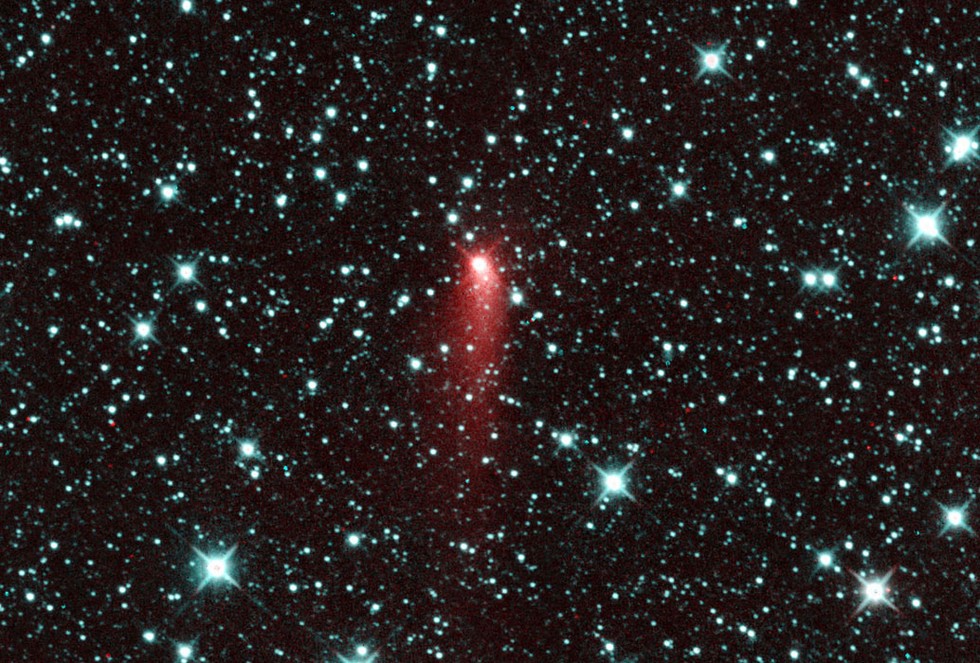WISE: NASA’s Infrared Asteroid Hunter

NASA's Wide-field Infrared Survey Explorer (WISE) is a space telescope launched in 2009 to map the entire sky in infrared wavelengths. Its goal was to find objects that had not been imaged before, including very bright galaxies, very cold stars, and nearby asteroids and comets.
When it launched, there were already two infrared telescopes in space — NASA's Spitzer Space Telescope and the European Space Agency's Herschel Space Observatory. What made WISE different was it imaged the entire sky, providing more context for the objects it observed.
WISE imaged the entire sky twice before running out of coolant in 2010. It then did a brief mission called NEOWISE, to look at near-Earth objects (NEOs) such as asteroids and comets, for four months before being placed into hibernation in February 2011. Less than three years later, in December 2013, the telescope was revived to continue its NEOWISE mission. That work continues today.
Primary mission
WISE was first proposed as a mission called the Next Generation Sky Survey in 1998, according to a slideshow on the WISE website at the University of California, Berkeley. Its development went as far as Phase A (preliminary analysis), but the concept was not selected for flight. The mission was re-proposed in 2001 and renamed WISE, with initial confirmation the mission would move forward in March 2004. The mission was led by Edward Wright of the University of California, Los Angeles.
WISE is part of a heritage of NASA's "Explorers" Program, which is the longest-running spacecraft program that NASA has. The very first of this series was Explorer 1, the first U.S. satellite, which launched in 1958. As of August 2014, the program has produced 89 successful and unsuccessful missions, according to the NASA Space Science Data Coordinated Archive (NSSDC).
Currently, the most expensive Explorer satellites — called Medium-Class Explorers (MIDEX) – are expected to cost no more than $200 million for development, launch services, mission operations and data analysis. The launch vehicle is not included in this cost. WISE was classified as a MIDEX mission.
WISE launched on December 14, 2009, and was eventually placed into a polar-circling orbit roughly 326 miles (525 kilometers) above the Earth. Using a scan mirror, the spacecraft was stabilized to take a picture every 11 seconds. This allowed for more than 7,500 images daily at four different infrared wavelengths.
Breaking space news, the latest updates on rocket launches, skywatching events and more!
The telescope was kept very cold (minus 430 degrees Fahrenheit, or minus 257 Celsius) using a cryostat, which NASA describes as "like an ice chest, but filled with solid hydrogen instead of ice." This frozen coolant was a known limit on its mission lifetime. In October 2010, the spacecraft depleted its coolant and its primary mission ended.
While two of the infrared detectors couldn't work anymore, there still were two others that could operate even without any coolant. So WISE began a new mission called the NEOWISE Post-Cryogenic mission, where it looked for near-Earth comets and asteroids. It continued work until it was placed into hibernation in February 2011.
Its major work during the primary mission includes:
- Finding no evidence of "Planet X" — a hypothetical planet that is supposed to orbit far beyond Pluto.
- Spotting a new class of stars, dubbed "Y dwarfs," whose temperatures are as cool as the human body.
- Discovering the most luminous galaxy in the universe, which shines with the brightness of 300 trillion suns.
- Seeing millions of black holes and some "extreme" galaxies known as "hot DOGS."
- Finding 20 new comets, more than 33,000 asteroids in the belt between Mars and Jupiter, and 134 NEOs.
NEOWISE reactivation
The spacecraft remained in hibernation for more than two years, but NASA elected to reactivate it in 2013. In a press release at the time, the space agency said it would like to use the telescope to seek new near-Earth objects. Additionally, NASA was working on an "asteroid initiative" where astronauts could explore an asteroid by 2025, and NEOWISE was seen as a potential help for that goal. The new principal investigator was Amy Mainzer at NASA's Jet Propulsion Laboratory in California.
The year before, a National Research Council NEO committee praised NASA's decision to fund the NEOWISE mission. Infrared asteroid surveys have an advantage over optical ones because the infrared detectors are better able to see low-albedo (low-brightness) objects, NRC wrote. "However, NEOWISE is not a stand-alone NEO survey and requires coordination with other surveys to make full use of its data," it added.
NEOWISE's work paid off quickly after it was reactivated in December 2013. "Just six days after the survey start, NEOWISE discovered its first potentially hazardous near-Earth asteroid, 2013 YP139," the mission website at the California Institute of Technology states.
By mid-June 2016, NEOWISE was beginning its sixth survey of the entire sky. At that time, it had made hundreds of thousands of measurements of 20,241 solar system objects, including 541 NEOs and 99 comets. The team was also looking at past data to try to find fainter comets and asteroids.
Major NEOWISE discoveries include:
Discovering fewer mid-size asteroids near Earth than previously believed, confirming that NASA had reached its Congress-mandated goal of finding 90 percent of large asteroids (which NASA was challenged to do in 1998, and achieved in 2011.)
- Finding the potential source — the Euphrosyne family in the asteroid belt — of a class of "dark asteroids" that have highly tilted orbits as they move near Earth.
- Locating the first "Trojan" asteroid that shares the Earth's orbit around the sun.
- Completing a count of potentially hazardous asteroids near Earth.
The spacecraft is expected to end operations in 2017 when its orbit moves into a zone with too much sunlight to do the surveys. Mainzer and her team, however, are working on a follow-up mission called the Near-Earth Object Camera (NEOCam). A proposal to NASA's Discovery program has been submitted three times, with the latest one being in 2015. A decision will be made in September 2016, with expected launch in 2021.

Elizabeth Howell (she/her), Ph.D., was a staff writer in the spaceflight channel between 2022 and 2024 specializing in Canadian space news. She was contributing writer for Space.com for 10 years from 2012 to 2024. Elizabeth's reporting includes multiple exclusives with the White House, leading world coverage about a lost-and-found space tomato on the International Space Station, witnessing five human spaceflight launches on two continents, flying parabolic, working inside a spacesuit, and participating in a simulated Mars mission. Her latest book, "Why Am I Taller?" (ECW Press, 2022) is co-written with astronaut Dave Williams.

